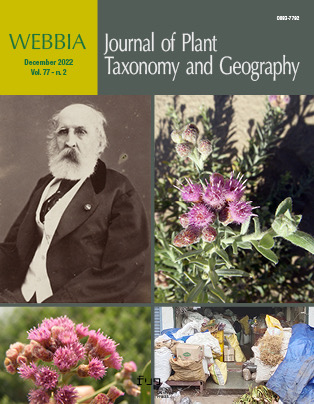Honoring Sabin Berthelot: Nomenclature and botanical history of Berthelotia DC. (Asteraceae, Inuleae)
Published 2022-12-15
Keywords
- Asteraceae,
- Berthelotia,
- Canary Islands,
- India,
- Sonora Desert
- Mexico,
- USA,
- Nomenclature,
- Phylogeny,
- Sabin Berthelot,
- Philip Barker Webb,
- Taxonomy ...More
How to Cite
Copyright (c) 2022 Andre A. Naranjo, Rahul R. Pathirickal, Kanchi N. Gandhi, Piero G. Delprete, Riccardo M. Baldini, Arnoldo Santos-Guerra, Lázaro Sánchez-Pinto, Javier Francisco-Ortega

This work is licensed under a Creative Commons Attribution 4.0 International License.
Abstract
The genus Berthelotia DC. (presently a synonym of the accepted name Pluchea Cass.), Asteraceae, Inuleae has been regarded as comprising two species, B. lanceolata DC. and B. sericea (Nutt.) Rydb. It honors the French naturalist Sabin Berthelot (1794–1880) for his contribution to the studies of the flora and fauna of the Canary Islands. Under the leadership of Philip B. Webb (1793–1854), Berthelot co-authored the most important work pertinent to the natural history of this archipelago: Histoire Naturelle des Îles Canaries. The nomenclature of Berthelotia and its associated names are revisited here. The holotype of Polypappus sericeus Nutt. (K000974653) was located, and lectotypes were assigned to B. lanceolata (G00450458) and B. lanceolata var. senegalensis DC. (G00452584). Phylogenetic analyses based on nucleotide sequences of the nrDNA ITS were conducted focusing on members of what is known as the Clade J of the Inuleae. A well-supported clade (100% P.P.) that we have labeled as “Clade I” was uncovered, and it is composed of three species that belong to the Pluchea indica Clade plus P. dioscoridis and P. ovalis; but this lineage did not support a previous hypothesis to include P. lanceolata. The two species of Berthelotia did not form a monophyletic group and seem to be distantly related; furthermore, none of these two taxa is sister to Tessaria, a South American genus that has been suggested to be a close relative to Berthelotia. Ethnobotanical uses of B. lanceolata and B. sericea are reviewed.


